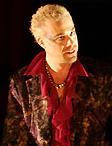SEARCH
REVIEWS
FEATURES
NEWS
Etcetera and
Short Term Listings
LISTINGS
Broadway
Off-Broadway
NYC Restaurants
BOOKS and CDs
OTHER PLACES
Berkshires
London
California
DC
Philadelphia
Elsewhere
QUOTES
On TKTS
PLAYWRIGHTS' ALBUMS
LETTERS TO EDITOR
FILM
LINKS
MISCELLANEOUS
Free Updates
Masthead
Writing for Us
A CurtainUp Review
The Revenger's Tragedy
By Shirley Safran
| Nine years’ vengeance crowd into a minute. --- Vindice |

Matthew Rauch as Vindice in The Revenger's Tragedy
(Photo: Samantha Moranville ) |
The play itself is a bit of a mystery. Published anonymously in 1607, it was first attributed to Cyril Tourneur. Subsequent scholarly research has determined that it is probably the work of Thomas Middleton, one of Shakespeare’s many contemporaries. While the heightened language is rich and flowery, as in Shakespeare, the play has more to do with revenge than with tragedy, since there is no tragic hero, no one character that excites our sympathy and no redeeming moral core. It paints Venice as a society mired in every form of corruption--a brothel steeped in a sewer--unrelenting in its depiction of vice, venality and viciousness.
Vindice, the revenger in the title, vows to revenge the murder of his beloved, Gloriana, nine years earlier, at the hand of the current evil Duke of Venice. Her skull, which he cherishes as a kind of talisman, becomes the instrument of his revenge in the first act curtain scene that is, in contemporary parlance, a total gross-out.
It would be an exercise in redundancy to enumerate all the acts of betrayal, nastiness, torture and murder in the action, but it’s all there to the accompaniment of thunderous bursts of orchestral music from The Rape of Lucretia and Otello (Iago’s great aria, Credo, ‘I believe in a vengeful God’). Unfortunately, there is no Desdemona in Venice to soften the poisonous atmosphere, since all the female characters are as venal as the men. The one virgin in the crowd, Vindice’s sister, is soon corrupted to the point where she chooses a life of whoredom, a role her own mother encouraged. Misogyny, promiscuity, incest, adultery, homoeroticism are all commonplace and deeply ingrained in Venetian society.
The depths of depravity exhibited here would be indigestible if it weren’t for the lively language and wildly irreverent humor. This play is seriously, darkly funny and the director and his enormously versatile cast have tapped into this blood-soaked humor for all it’s worth. The action moves like a speeding bullet; the actors, athletic, graceful and articulate (they literally spit the words out) grab you with their energy, audacity and glee. Especially fine is Matthew Rauch as Vindice, who turns in a fierce, funny and intelligent performance. But then, so do they all.
Jesse Berger, the director, should be commended for his visual imagination in staging this play in such inhospitable surroundings. The actors are clothed in what looks like remnants pulled out of a trunk full of Mardi Gras costumes. No attempt of verisimilitude here. He pushes the limits in the extremely graphic, bloody death scenes. If this were a movie, it would be X-Rated and I wouldn’t go near it. But in the theatre, disbelief is willingly suspended. We all know it’s fake, so revel in it.
As a kind of visual parentheses, the play opens with a masque, a dance macabre, depicting the rape of Antonio's wife who personifies the law. It closes with another masque choreographed in Kabuki style, which ends in wholesale slaughter and the ascension of Antonio as the new Duke of Venice, who promises, in a high-minded but smarmy speech, to promote the rule of law. The final tableau, showing him about to be sexually serviced by Vindice’s sister, is a stunning visual comment on the immutability of human nature: the more things change, the more they are the same. Welcome to the 21st century.
| REVENGER'S TRAGEDY Originally attributed to Cyril Tourneur, but probably the work of Thomas Middleton Directed and adapted by Jesse Berger Cast: Scott Barrow, Denis Butkus, Jason C. Brown, Aaron Clayton, Saudia Davis, Kimberly Dilts, Amefika El-Amin, Ryan Farley, Ty Jones, Daryl Lathon, Claire Lautier, Paul Niebanck, Chris Oden, Petronia Paley, William Peden, Naomi Peters, Matthew Rauch, Russ Salmon, Daniel Cameron Talbott, Haynes Thigpen, Marc Vietor Set Design: Evan O'Brient Costume Design: Clint E.B. Ramos Lighting Design: Peter West Music: Daniel Levy Choreographer: Tracy Bersley Fight Director: J. David Brimmer Masks: Emily DeCola Running time: 2 hrs, includes 1 intermission Red Bull at 45 Below 45 Bleecker Street, www.45bleecker.com 11/28/05 to 12/23/05 first run extended to another run from. 1/06/06 to 1/22/06 Monday at 7pm, Wednesday-Friday at 8pm, Saturday at 2pm and 8pm, and Sunday at 3pm. Tickets $40, $20 Student Rush at the box office 1 hour before performances with ID. Reviewed by Shirley Safran based on January 7th performance |

Easy-on-the budget super gift for yourself and your musical loving friends. Tons of gorgeous pictures.

>6, 500 Comparative Phrases including 800 Shakespearean Metaphors by our editor.
Click image to buy.
Go here for details and larger image.








